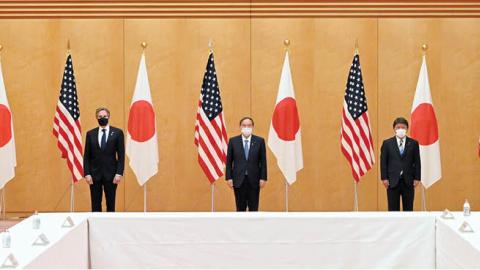On Friday, Prime Minister Yoshihide Suga of Japan will be the first head of government welcomed to the Biden White House. This is no coincidence: given Xi Jinping’s hegemonic aspirations for China, Japan has increasingly emerged as America’s most important ally.
The Biden-Suga summit could accelerate a transformation of the bilateral relationship, in which the once-vanquished Japan emerges as a full and equal partner of the U.S. But Japan needs to do more to assume this critical role.
The groundwork for this change has been laid by Suga and President Joe Biden’s predecessors, Shinzo Abe and Donald Trump, who understood that the U.S.-Japan relationship could be the “special relationship” of the 21st century. Trump consulted with Abe more than with any other international leader, and he regularly deferred to Abe’s judgment. They did not always agree — Trump rejected participating in the Trans-Pacific Partnership multilateral trade compact — but our governments aligned doctrines and strategies to meet pressing challenges from China.
Critically, Trump followed Abe’s lead in embracing Japan’s Free and Open Indo-Pacific Vision. This transformative strategy, grounded in Japan’s broadened understanding of both the Pacific and Indian Oceans as spheres of competition with China, seeks to promote security cooperation, the rule of law, freedom of navigation, trade, and high-standard international development in a region that is home to three-fourths of global commerce.
To compete with China’s One Belt, One Road program, in close consultation with Japan, the Trump administration restructured international economic assistance. The U.S, moreover, established whole-of-government cooperative initiatives with Japan (and Australia) to promote energy and cybersecurity, and high-quality physical and digital infrastructure. And significantly, the Quad grouping of the Indo-Pacific’s four great democracies, Australia, India, Japan and the U.S., was reinvigorated and raised to the ministerial level.
Biden and Suga are building on this firm foundation. In early March, the Quad held a historic leaders meeting, expanding beyond consultations, development coordination and security exercises to working groups on technology and climate change, as well as a bold initiative to produce and distribute 1 billion COVID-19 vaccines to Southeast Asia.
A March 13 joint statement from U.S. Secretary of State Antony Blinken, Secretary of Defense Lloyd Austin and their Japanese counterparts underscored mutual appreciation for the threat posed by China. It spoke bluntly about China’s “coercion and destabilizing behavior” in the region, including incursions near the Senkaku Islands, threats to Taiwan, and human rights violations in Hong Kong and Xinjiang.
The Biden-Suga summit will echo this firm rhetoric on China, affirm U.S. treaty obligations to defend Japan in the event of an attack on the Senkaku Islands, and take the important step of including Taiwan by name in noting the importance of peace and stability in the Taiwan Strait. New initiatives to enhance supply chain resilience and international development cooperation to compete with China on 5G and hydrogen power are also expected to be announced.
What do these developments indicate? Three-quarters of a century after the end of World War II, a democratic Japan, anchored firmly in the U.S.-Japan alliance and in the principles of the free and open Indo-Pacific, is ready to come into its own as a global power.
But Japan needs to go further: as a frontline nation in the strategic competition with China, Japan needs to make its territories and waters increasingly inaccessible to Chinese incursions. At a time when China is investing heavily in next-generation, networked defense technologies, Japan should do the same and bolster its deterrent. Japan has increased defense spending each of the last nine years, and augmented capabilities significantly, most especially with the purchase of 147 F-35 joint strike fighters, the signature product of Fort Worth-based Lockheed Martin Aeronautics. But Japan needs to spend more (and allocate funds more effectively) to move from defense to deterrence.
The U.S. should deepen defense industrial cooperation further to meet the China challenge through co-development of next-generation defense capabilities. The U.S. can help Japan bolster its national security infrastructure by further incorporating Japan in our defense supply chain, and by including Japan, as we do other key allies, in our national technology and industrial base.
Part of the challenge, however, lies in the Japanese constitution itself. After World War II, in transforming occupied Japan into a peaceful, prosperous democracy, the U.S. dismantled Japan’s war-fighting capabilities and put in place a constitution that renounces the “use of force as a means of settling international disputes.” Even reinterpreted, as it has been, to allow for collective self-defense, Japan’s constitution may still pose obstacles to preemption and effective joint operations.
The retired chief of staff of the Japanese Joint Chiefs, Adm. Katsutoshi Kawano, said it best: “Japan should have a stronger sense of ownership” in the event of a Chinese invasion of Taiwan, as the Taiwan Strait lies next to Japan. Accordingly, it is essential that Taiwan be on the agenda for the Biden-Suga summit.
Japan has found its voice with its blunt criticism of Xi’s increasingly aggressive and repressive actions. There is no better moment for Japan to move toward greater security engagement on its own behalf.
Read in The Dallas Morning News



















